Digital transformation (DX) and Industry 4.0 inevitably change the future of work, requiring a work transformation for an increasingly digital economy and work environment.
The future of work has been one of the hottest topics in conversations regarding the evolution of business, our built environment, and our lives since the accelerating adoption of digital technologies.
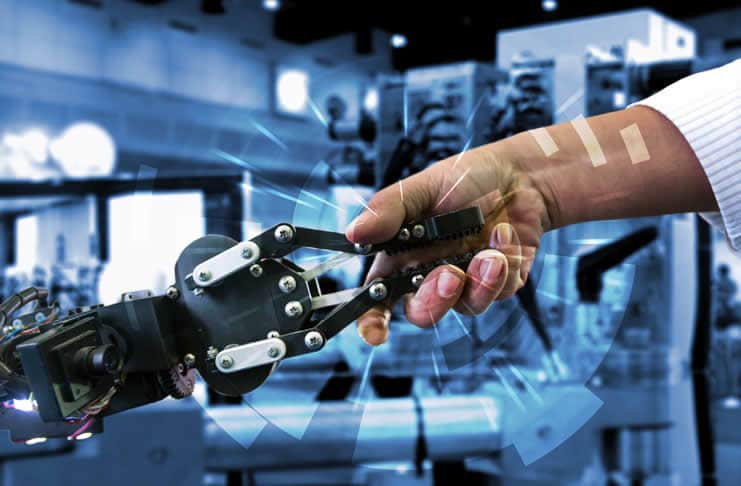
And how else could it be? In our societies, work is essential throughout most of our lives, and certainly not just for financial reasons. And technology? Well, it suffices to spend a few hours in a city or town nearby and look at what people do, even if it’s just with their mobile digital Swiss army knives. Digital devices and applications have become omnipresent across everything we do, work included.
The future of work is now. Digitalization and globalization have sparked radical shifts in how we live and work. The coronavirus (COVID-19) crisis has accelerated these beyond anything we could have imagined. (OECD)
It’s clear that the areas where work and technology meet and overlap multiplied over the years. Today we even have digital platforms to (learn to) work with high-tech machines and various digital systems we encounter at work and are required to use for our job.
And the growing importance of technologies inevitably translates into ever more work-related technology-intensive matters: digital HR and talent management, digital/social collaboration, smart offices, agile work models, all those new required skills, the changing job market, you name it.
To some (an increasing) extent, we want more tech at and for work (think about the whole consumerization phenomenon and demand for more hybrid work models, for instance). And the companies where we work deploy ever more technologies across the board as they continue to transform, with a digital transformation of HR and even work transformation as a consequence/necessity.
The future of work and technology – a vast range of questions to address
Topics such as digitization, automation, digital transformation, robots and cobots, artificial intelligence, the concept of Industry 4.0, and more increasingly started taking center stage in ‘future of work’ debates, as did the impact of several technologies and new types of applications as such (e.g., robotic process automation or RPA, IoT, AR/VR, etc.).
And since all these changes/topics are pretty vast and impactful, people increasingly understood that technology would profoundly impact work as such, perhaps even more than they once believed.
In recent years, the public debate on the future of work often revolved around the impact, fears, and forecasts regarding employment with the acceleration of a digital economy and ever more automation in mind. It’s still an important topic, even if in some organizations, the usage of a few mentioned types of technologies and automation isn’t new anymore.
A second perspective obviously concerned the benefits and requirements of a more digital world – and world of work – for organizations and employees alike. And to realize their digital transformation strategy goals, businesses would need more agile work models, ‘digital workers’ (digital-savvy workers with technology skills/experience), different types of managers, and HR people; the list is long.
Traditional work models do not provide the agility, scalability, and resilience required by the future enterprise. (Holly Muscolino, IDC)
It remains a crucial issue as well. Virtually every day, we are reminded that many innovation and transformation efforts remain stuck because organizations lack specific skills and need ‘digital factory workers‘ or whatever type of workers/experience in whatever area you can think of. Without changes in work models, work culture, and skills, digital and industrial transformation initiatives are known to fail or stall, remaining in pilot mode forever.
And there are older work and technology issues we still need to solve. Earlier, we mentioned the consumerization of IT. Well, it isn’t that long ago since we last talked about it or BYOD and BYOx, the digital workplace, smart workplaces, remote work technologies, the use of tools and platforms for specific functions, etc. And can we genuinely say that knowledge workers nowadays dispose of all the – combined and treated – data, information, channels, and tools to do their job as customers/others expect it, with information silos being one of the oldest information management challenges?
Finally, there’s increasing attention for pretty advanced work and technology evolutions that aren’t on the agenda (yet) for many organizations. They are more for technology-intensive organizations, larger companies, specific verticals where digital transformation is key for ‘survival’ and (thus) the whole future of work and technology narrative of the tech industry and tech-oriented analysts where the future is always on the radar.
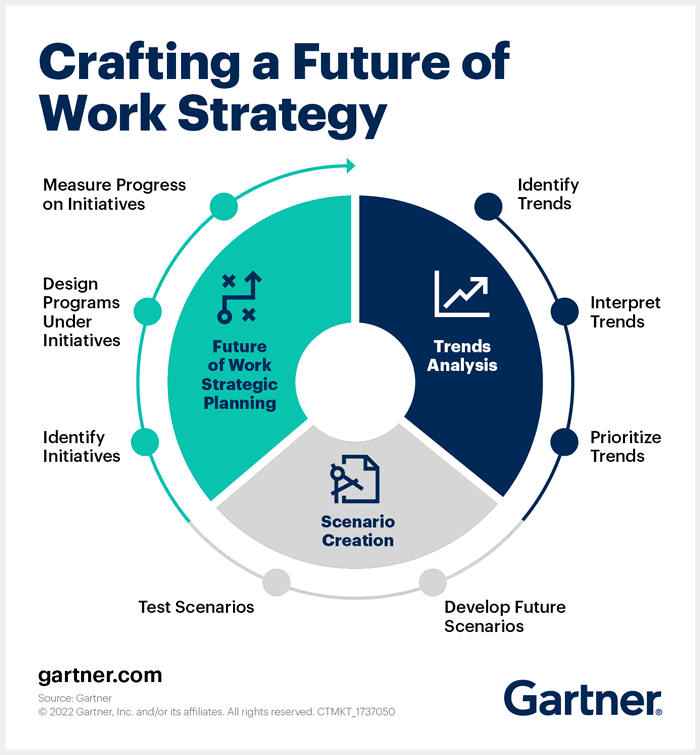
We take a closer look at these work transformation visions, technologies, and new work models for a digital economy below. They go hand in hand with views on the needs of future organizations as they continue their digitalization efforts for a digital future where ‘human workers’ are joined by ‘digital workers’ and so-called human augmentation and new automation tech.
The future of work and work preferences/needs during and after the pandemic
Not all the topics we mentioned so far are relevant for you or your business (today). Perhaps only some are still valid for your future of work questions or priorities. And there certainly are others we haven’t mentioned – yet.
Perhaps you have been looking at intelligent office, and physical workspace approaches for the changing workforce and work models with (future) work scenarios like those described in an interview on building system integration we published just before the pandemic hit. Think generation Z workers and devices and tools that recognize the worker and adapt the settings of their environment to their profile. Or different types of offices with some perhaps evolving into smart meeting points, you’ve seen some scenarios and the smart building technology exists.
Without changes in work models, work culture, and skills, digital and industrial transformation initiatives are known to fail or stall, remaining in pilot mode forever.
Last but not least, there is, of course, that pandemic and all its consequences, making the future of work all the more challenging for all the reasons we know, including its impact on a social, societal, personal, emotional, and even mental level. We’ve all been there with differences per country, industry, job function, government measures, and more parameters that still impact what we do, certainly in less technology-intensive sectors.
The drivers of the evolution of work and the vast number of subtopics regarding technology and work were joined by newer and previously less essential matters. Moreover, the intersection between both topics took on whole new meanings in different perspectives.
For many organizations switching to digital and remote forms of work, collaboration, etc., became a sudden matter of business continuity and even survival. Numerous people across the globe started using digital tools for purposes they never had before.
As you know, the levels of remote working skyrocketed during lockdowns with differences per sector and function. As you can read in a piece on digital transformation in the next ‘normal’ it became clear that many workers wouldn’t want to stop working from home entirely (those who could, of course).
The impact of remote work in the mix of hybrid work approaches will still dominate work debates for several years across several domains, especially regarding knowledge workers (especially in the beginning). But more on that later. The same goes for all the debates that started on what pandemic-induced changes would stay and be deemed essential for the future by executives, workers, and other stakeholders.
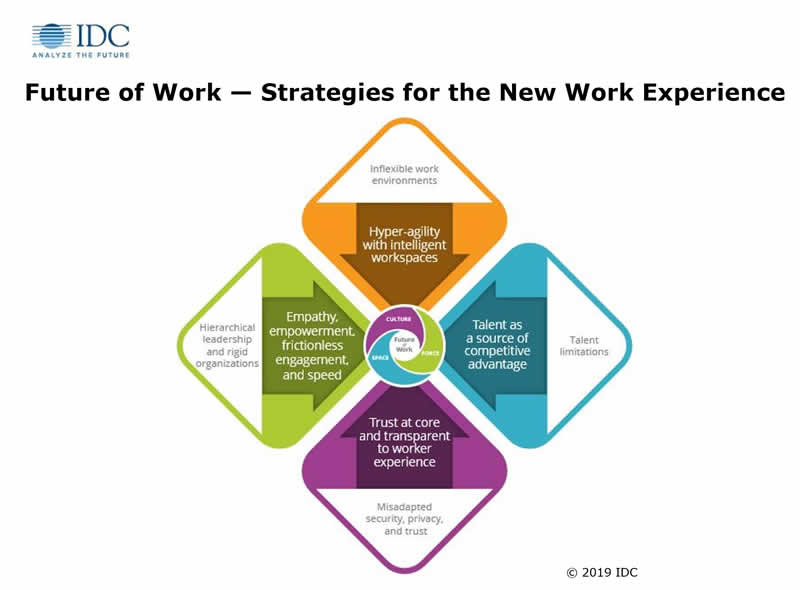
The need for a holistic view and staying connected on all levels
The pandemic and its consequences aren’t over, but the dust started to settle so we could look back and ahead, also in the context of work. As far as the future of work is concerned, we know that the picture is far more complex, dynamic and unpredictable than before.
This is even more so because the challenges and evolutions (demographic and technologic ones included) didn’t stop, and already before the pandemic, we were approaching a tipping point. Moreover, there are all these innovations that already seemed to come our way and now get even more attention.
It’s clear that there will be quite some differences between various regions and depending on the type of work one does and sector to understand which future work scenarios are more – or less – applicable.
We certainly also have to look at the role of policymakers and the plans across different countries and regions to boost their economies. There are clear priorities on speeding up digital economy initiatives and resilience in several. And, of course, organizations, groups of workers and people, have learned lessons too and look at digital for business resilience and future disruptions, whatever they may be. The need to stay connected, no matter what, and continue as much as possible ranks high on the agenda, with resiliency sometimes deemed more critical than sheer efficiency or productivity.
In the coming years, when talking about the future of work, we will inevitably have to talk about all aspects, including worker safety, commercial real estate (smart offices in hybrid work contexts), and even how attitudes regarding work as such have changed among quite some people.
Having a holistic view will be more critical, and executives that want to attract and keep the talent they need will require the advice of experts in areas they aren’t too familiar with.
We mentioned some other topics in the said piece on the ‘new normal’ and digital transformation and the pandemic: workspace and workplace, learning and training, the very nature of some job functions, equal protection of all workers, wellbeing and mental support; the list is long, and it contains far less evident topics than all these.
Last but not least, there are several questions regarding the workers and skills that will be needed if organizations and governments continue to advance their digitalization plans and the ‘digital worker’ joins the human one.
As said, that’s not a new topic either, but given these plans and the fact that time and again, a lack of needed capacities/culture proves to hinder them, it will become even more critical. As will the role of HR, digital HR, of course. As you can read in our article on HR in digital transformation, HR is essential to enable such transformation projects and, among others, close skill gaps. Hiring and keeping the right people and changes in the ways we ‘lead’ and change management skills are paramount.
Organizations globally are experiencing seismic changes in where and how to work. The adoption of technologies such as artificial intelligence, robotics, and intelligent process automation are speeding this transformation.
The future of work? A complex matter indeed. Or better: many challenging, intertwined issues for years to come. With that need to stay connected, certainly not just on a technology level, first of all on a human level and a level of access to resources, with the help of technologies. And in many regards, not a finished story as there are already significant differences between what workers and employers want – how else could it be?
And the impact of the pandemic? We have to be honest and realize there is still quite some uncertainty regarding several (future) work transformation areas. So, even if the changes are profound, perhaps some are a bit premature or pushed as hyper-important by those interested in seeing solutions enabling these changes bought. But that’s nothing new. We don’t have a crystal ball, but some ‘dramatic changes’ might turn out to be that tad bit less dramatic depending on the pandemic’s evolution. Especially sociologists remind us that people forget terrible events and turn to old habits way faster than many seem to think.
Future of Work (FoW) – work technology and transformation spending across work culture, workspace, and workforce
Much attention in future work topics continues to go to the technologies related to the evolving ways we work and the work transformation deemed essential for ‘survival’ and differentiation in an ever more digital business world.
Assessing the value of that worktech (work technology) and work transformation market isn’t easy. First, there is the challenge of what exactly we include. Platforms to collaborate, remote work applications, wearables for specific groups of workers, digital workplace and workspace technologies, etc., seem obvious choices.
But what about the services and solutions organizations invest in to enhance offices and move to a healthier, more efficient, attractive, and ‘smart office,’ including the required IoT applications? Talent management? Training? Optimizing and measuring the employee experience? Novel technologies and use cases? The collaboration between human workers and machines? Automation platforms? Digital HR? Entirely new methods and technologies to prepare for a more digital future?
They are all part of the broader, holistic picture of the future of work we mentioned, only covering the more direct technology part.
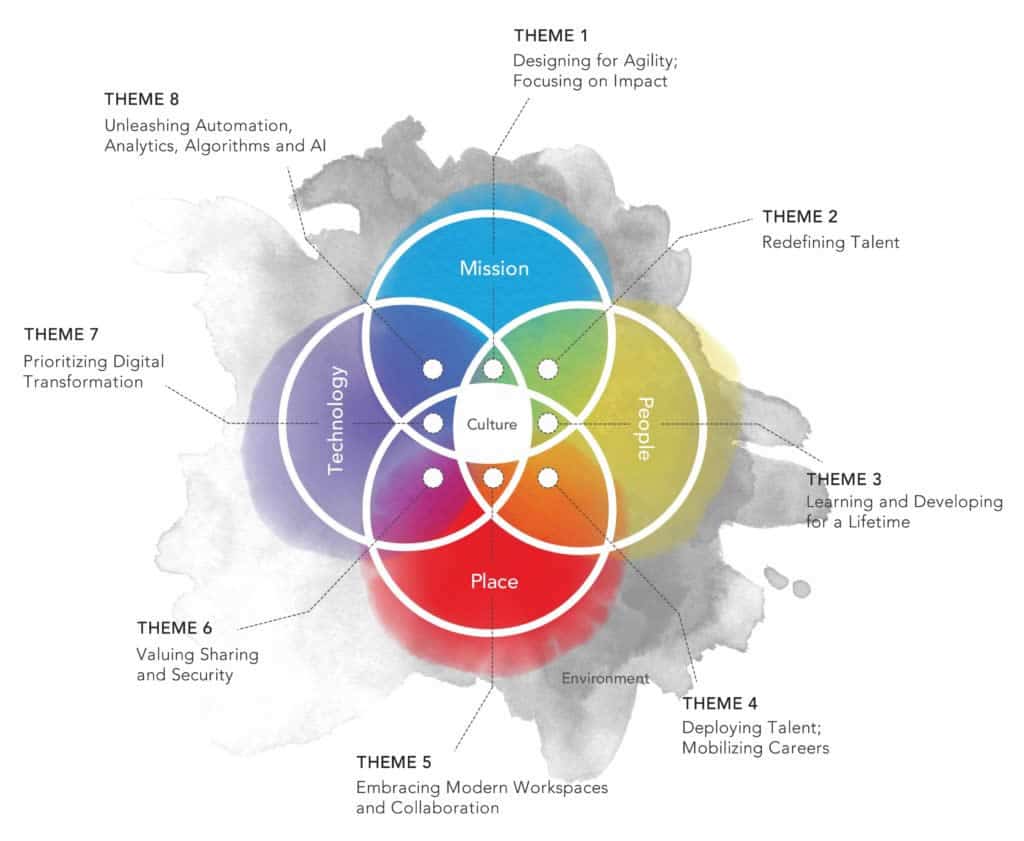
A Future of Work (FoW) framework NASA developed based on research to embark on a new future workforce journey – source and research
Virtually all consulting firms, research companies, and vendors talk about the future of work nowadays, often with a different angle since it’s become such a vast and essential topic.
But also organizations do their Future of Work homework, including HR officers. Even NASA has a Future of Work framework (see image), an initiative of its Office of the Chief Human Capital Officer (OCHCO), “to understand the disruptors driving the future of work and implications for NASA so that it can evolve talent strategies aligned with the new work, workforce, and workplace of tomorrow.”
Although it goes back to the end of 2018, many topics certainly are on the agenda of organizations. NASA made the framework to serve as a foundational compass as it ’embarks on a new journey toward a future that enables its workforce to be adaptable, resilient, productive and bold.’ Resilience and adaptability definitely are hot topics nowadays, as you know, with the most-used business term since the pandemic, no doubt being business resilience.
Investments in future of work initiatives 2021-2024 per IDC
IDC (International Data Corporation) started a future of work practice a few years ago. In June, the research firm released new findings on future of work technologies and services, including spending intentions for 2021 and the forecast period through 2024.
With IDC, we’re in our context of digital transformation since its Worldwide Future of Work Spending Guides are based on its Worldwide Digital Transformation Spending Guide and “determine FoW-specific opportunities by sizing the DX technologies that fundamentally change the worker experience and/or role of the human worker.” FoW is short for Future of Work, and DX is short for digital transformation.
According to IDC, the evolution towards the new workplace and changing workforce is expected to drive a total investment in future of work technologies of almost $656 Billion in 2021.
That’s an increase of 17.4% over 2020. By 2024, investments in technologies supporting Future of Work initiatives are forecasted to exceed $1 trillion worldwide (compound annual growth rate of 17 percent over the forecast period).
The future of work is about rethinking the way work gets done. It is a fundamental shift in the work model to one that fosters human-machine collaboration, enables new skills and worker experiences, and supports an intelligent and dynamic environment unbounded by time or physical space. (IDC)
IDC states that all aspects of how our organizations and we work are evolving, accelerated by the pandemic, and enabled by third platform technologies (the interplay between cloud computing, social, mobile and information/analytics/big data, and innovation accelerators such as IoT).
From an industry perspective, most spending in future of work is in discrete and process manufacturing over the entire 5-year period. So, definitely not white-collar workers alone (with apologies for an old term, workers are workers) – it’s time to look at Industry 5.0 since that is a lot about people and machine collaboration.
Among the main work transformation goals and use cases for which manufacturers invest in FoW technologies: automated decision support, virtual collaborative approaches, collaborative robotics (e.g., cobots, now in high demand), operational performance management, and 3D and digital product design and review for improved cost control and higher process efficiency.
In total (discrete and process combined), FoW spending of the manufacturing sector should account for a little over a third of all future of work tech spending.
The following three industries in terms of FoW spending in 2021 are professional services, retail, and banking.
However, Future of Work spending is spread across many industries, with some that will grow fast in the next few years. The fastest-growing industries over the entire 5-year forecast period per IDC are, respectively:
- the construction industry with a CAGR of 23.7%,
- the media sector with a compound annual growth rate of 19.5%, and,
- the retail industry with a five-year CAGR of 19.3%.
As per usual, IDC looks at three categories of spending: hardware, software, and services.
• Hardware is the main area of investment in Future of Work technologies in 2021, expected to reach a total of $228 billion ‘in endpoint devices, enterprise hardware, infrastructure as a service (IaaS), and robotics and drones.’
• Services rank second with spending at more than $123 billion, including business, IT, and connectivity services.
• Software ranks third in 2021 but will see the fastest spending growth with a CAGR of 21.3% over the 2020-2024 forecast period. Software includes spending in enterprise applications, content and collaboration, analytics and artificial intelligence, human resources applications, security, and software development and deployment.
As you can see, FoW initiatives do encompass quite some types and categories of hardware, software, and services. In other words: IDC’s FoW spending guide does cover quite a bit which could prove to be a challenge over time.
Yet, while these spending numbers no doubt are interesting for vendors, for organizations seeking to leverage Future of Work technologies and services, the use cases are far more critical. This really should be the case for all technology investment forecasts now: only use cases, applications, and outcomes matter in the end. People and businesses want solutions. Fortunately, IDC has done its homework here as well.
If you’re wondering what FoW use cases your peers seem to find exciting or deliver a good return:
• in 2021 FoW use cases that will benefit from most spending per IDC include collaborative robotics, operational performance management, and automated customer management while
• over the 2020-2024 forecast period, adaptive skill development, interconnected, collaborative workspaces, and advanced project management are the use cases that are expected to see the fastest spending growth.
The future of work – several views and frameworks
IDC has organized the topics for its future of work technologies research around three issues with slight changes in the wording of one after the official announcement of the FoW framework (see the center of the image below):
- work culture (‘culture’),
- digital and physical workspace (‘space’),
- how humans and machines collaborate to get work done (‘augmentation’; in a previous version ‘power’).
The company also identified four work transformation goals. In the words of research vice president Holly Muscolino (see video here):
- enabling hyperagility with intelligent workspaces,
- leveraging talent as a source of competitive advantage,
- making trust the core of the organization and transparent to the worker experience, and
- leading to encourage an environment of empathy, empowerment, frictionless engagement, and speed.
Check additional details on some of the fastest-growing categories, applications, use cases, and categories in work technology according to IDC.
Also look at the detail page of the FoW spending guide for an overview of the precise topics and spending areas covered. IDC mainly looks at digital transformation technologies changing how we work (‘work transformation’), not – or less – at other topics regarding the future of work you might be interested in, such as inclusion and diversity, job market disruption, or workforce happiness.
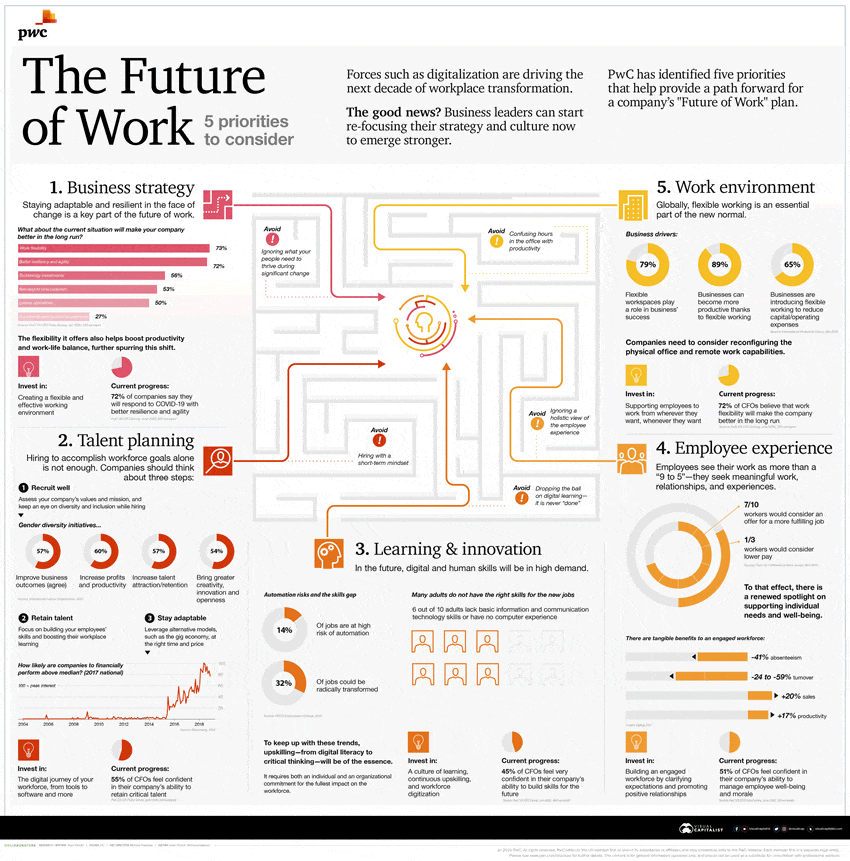
Stay tuned for more future of work forecasts, challenges, topics, and visions.
Top images: Shutterstock – All other images are the property of their respective mentioned owners.

